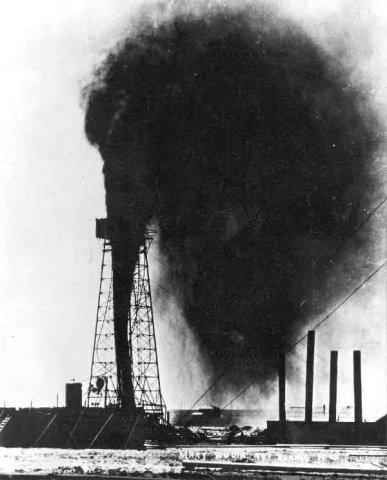Description:

The early morning of March 26, 1930 was not a quiet one. Things were never quiet in the year-old Oklahoma City oil field. The shouts of men, the whirring of drills, the hissing of gas and rythmic ka-chunk of the pumps produced a cacophonous symphony of economic activity. On clear nights the clang of tools on pipe could be heard from the drilling sites centered at SE 59th and Bryant all the way to Belle Isle.
For the crew working on the #1 Mary Sudik well, now down around 6,400 feet, it had been a long, noisy night of drilling. The crew was one of many for the Indian Territory Illuminating Oil Company (ITIO) working in the area. This particular well was on a lease secured from Mary Sudik and her husband, Vincil, Bohemian immigrants who had purchased 160 acres in 1903 for a dairy farm. The Sudik farm was quite successful and the couple had recently purchased a home in Capitol Hill in preparation for their impending retirement. They hoped leasing the mineral rights on their land would give them enough money to pay their property taxes.
The exhausted crew forgot to secure the hole with mud before leaving and just as they climbed off the derrick, a deafening roar boomed out as a pocket of gas exploded through the hole. It was soon followed by a gush of oil propelled by the force of the exploding gas. The oil had a mixture of fine sand (Wilcox sand) in it and the force of the gusher made the sand act as a cutting tool, slicing pipe and eventually ripping the top off the derrick. Crews in the area rushed in to cap the well, but each time the Mary Sudik blew out the fittings. By the end of the day she was ‘Wild’ Mary Sudik.
Hours became days and crew after crew from the army of ITIO engineers and veteran drillers from all over Oklahoma came in to try and tame ‘Wild’ Mary Sudik. Nothing seemed to work. Crews had to don goggles and wear scarves over their faces to prevent breathing in the gritty black crude. They used hand signals to commmunicate with each other because the roar was so loud that they couldn’t hear even the shouts of the nearest man.
Meanwhile ‘Wild’ Mary was blowing (by some estimates) 20,000 barrels of oil and 200,000,000 cubic feet of gas into the air every day. A strong March wind blew out of the north and sprayed oil all over the countryside south of the drilling site. As far away as Norman – 12 miles – buildings at Oklahoma University were stained with a fine greasy mist. Chemists said the oil had mixed with the gas to form oily globules much like soap bubbles which were carried on the wind and then would burst upon hitting something and leaving a small splatter stain. Forutnately, no population centers were in too much danger but there were reports of some farm structures and even automobiles catching fire when the flammable mist fell on them.
‘Wild’ Mary Sudik roared on. She attracted the attention of the national news media and soon her exploits were reported all over the globe. Reporters from the New York, Chicago, San Francisco and even London newspapers came to interview Mary Sudik, who seemed more eager to talk about her new grandchild than the gusher which bore her name. Floyd Gibbons, an early radio superstar, made two daily reports about ‘Wild’ Mary Sudik on his national broadcasts.
Soon a week had passed and ‘Wild’Mary roared on. Crews from all over the country came to try and rein in the ferocious well. After 11 days, on April 6, a crew led by H. M. Myracle, using an apparatus engineered especially for the wild well, was able to swing a die nipple in place and cap the hole. The Sudik well was finally tamed, but no one will ever know how much oil and gas was wasted trying to cap her. We do know that 211,859 barrels of oil were retrieved from pits and trenches dug around the derrick to catch as much oil as possible. And farmers had to be compensated for the thousands of acres of farmland soaked by ‘Wild’ Mary’s oil.
There would eventually be thirteen wells on the Sudik lease and tens of millions of barrels of oil would be drawn from it. Some of the wells produced for over 40 years. The Sudiks obviously became very wealthy. Did they move to Beverly Hills? No, they stayed right there in the little house on SW 24th in Capitol Hill – Mary had to be near her grandchildren.